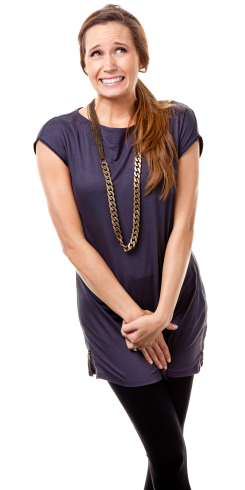Gotta go?! It may not be the ‘pause
Urinary incontinence, that is, involuntary leakage of urine, affects up to 30% of women in the United States and is expected to grow exponentially as the population ages. Usually classified by type, it can be devastating to quality of life and overall wellbeing. The three main types include:
- Stress urinary incontinence (stress incontinence), i.e. involuntary loss of urine caused by physical stress (coughing, lifting, heavy activity) and is often related to the weakening of the pelvic floor muscles after pregnancy.
- Overactive bladder (urge urinary incontinence), that is characterized by an urgent and mostly unavoidable need to urinate relating to a dysfunction of the bladder muscle and how it contracts.
- Mixed incontinence, i.e. a combination of the two.
In the interest of full disclosure, I was immersed in the topic for almost 5 years; I was acting in an advisory capacity to Merck Consumer Care who recently received marketing approval for Oxytrol For Women. Oxytrol for Women is an over the counter transdermal patch for overactive bladder. However, that’s not why I am writing about it; I have wanted to address urinary incontinence for a long time on this blog but could not do so since I had a conflict of interest. Now that that conflict is gone, I am finally able to share information, and more specifically, whether or not urinary incontinence is linked with menopause and hormone deficiency as estrogen starts to decline. Reports suggest that roughly 8% to 27% of menopausal women suffer.
Until now, only a few studies have truly focused on women between the ages of 45 and 60, i.e. what I often call the ‘menopausal set.’ More importantly (and what you need to know): when French researchers conducted a thorough review of 29 studies, culled down from an initial total of 488, they found that the connection between menopause and urinary incontinence is tenuous at best.
In fact, in one of the largest studies that they looked at — the Study of Women’s Health Across the Nation (SWAN, which followed 1,529 women annually for 6 years– they found that the data show that during perimenopause, women have a one and a half times greater risk for urinary incontinence, but this risk disappears when they reach menopause. In an associated study, SWAN researchers reported that data linking menopause to a worsening of incontinence symptoms appears to be due to weight gain and not hormones. Ironically, other studies have linked the decline in estrogen to improvements in urine incontinence symptoms.
So, what about HRT? Where does it fit into the picture if the link between menopause/estrogen decline is weak? Well, when the researchers looked at that data, they found that type of incontinence and how HRT is administered does matter. Both the Nurses Health Study and the esteemed Cochrane Database have shown that oral HRT increases incontinence risk and worsens symptoms, while topical treatments may actually improve symptoms and number of episodes.
The researchers write that menopause has little if any impact on the risk of urinary incontinence in general, especially when other factors such as weight gain or age are taken into account. The good news for women with stress incontinence is that the condition appears to decline after menopause, although, granted, a mixed bag may take its place. And oral HRT? Buyer beware! If you’ve got either stress incontinence or overactive bladder, it may worsen your symptoms!
Urinary incontinence may be as much as taboo subject as vaginal atrophy. But it’s definitely one that needs to be talked about, especially as more and more women transition into midlife. Fortunately, it looks like menopause is not the cause, which should bring a sigh of relief. Meanwhile, gotta go? Talk to a health practitioner. Stress incontinence can often be successfully controlled through pelvic floor exercise, and overactive bladder symptoms may benefit through a combination of exercise and drugs. The main thing is to realize that you don’t have suffer alone; there’s a lot of leakage going on.
Read More






